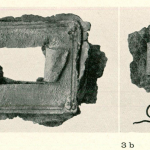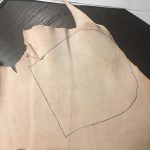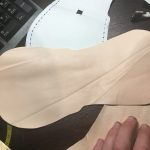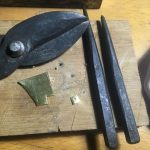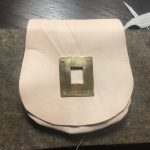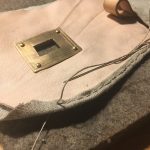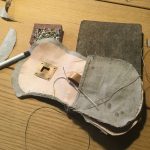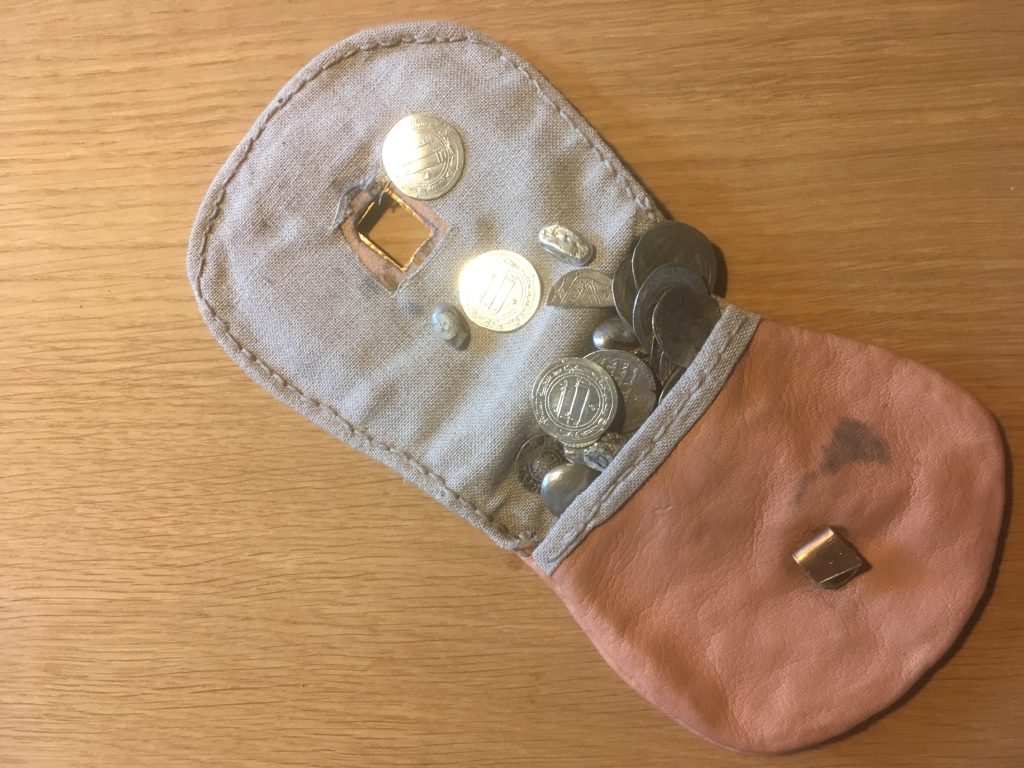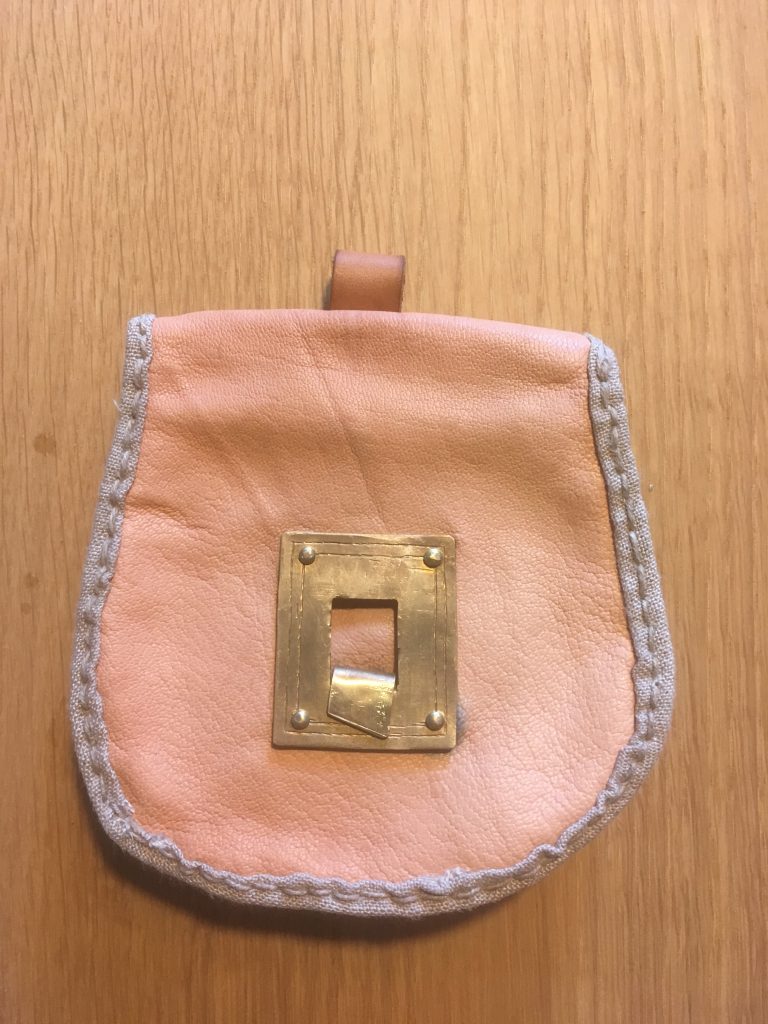The grave 716 in Birka is famous especially for its richly-decorated Magyar belt, which was one of my first projects in Viking reenactment (see here: Der Gürtel vom orientalischen Typ aus Birka Grab 716). However, this grave also contained the metal, leather and linen remains of what was most certainly a belt pouch. [Interestingly enough, Inga Hägg seems to have mis-interpreted the remains as a leather caftan with metal loops in a paper from 2001.]
The find
The pouch was a lot simpler than most tarsoly finds from Scandinavia and other tarsoly-bearing countries (especially the Rus dominion as well as the Magyar and Bulgar Khanates). Instead of the usual center mount with floral/palmette designs, cast from copper alloy, this pouch had a simple metal sheet with line decorations as a center mount.
The interesting part, though, is not the center mount, but the little piece of metal bent to it. It’s a metal hook or clasp, and was used to close the bag instead of the more common „pull the strap through the slider“ principle which is well-documented for many other extant finds.
This means that in addition to the two well-known principles of closing a tarsoly,
- with the center strap pulled through a slider and the center mount, like the Rösta bag or the bag from Bj93
- With a little buckle that slid into the center strap, like the Panovo pouch,
there is a third option being realized in Bj716. The hook was riveted with one rivet to the leather underneath, and held the bag closed when it was clasped into the center mount. I will elaborate at the end of this article what I think this means.
Leather and linen
The remains of the pouch leather have some „textile“ attached to it, as per the find description in the SHM database.
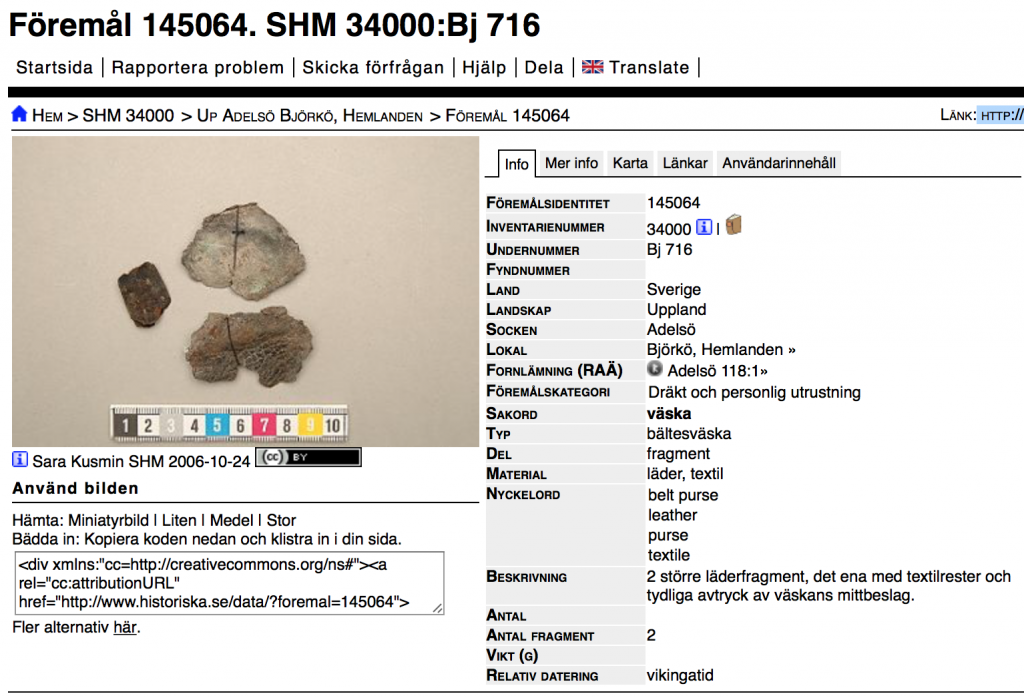
Now, is that textile wool or linen? An interesting question and neither the Birka books nor the SHM database offers an answer.
There is a paper by Inga Hägg from 2001 named „Methodische Probleme der Erforschung ur- und frühgeschichtlicher Gesellschaftsstrukturen am Beispiel Birka“ (transl. „methodical problems of researching antique society structures at the example of Birka“) (to be found via Google Books: Festschrift für Helmut Ziegert) in which she writes, in my opinion incorrectly, about the grave Bj716:
"Der Tote in Grab Bj716 hatte ein leinengefüttertes Gewand (Kaftan?) aus Leder mit Lederösen und Bronzeknöpfen in der Öffnung vorn und einen Ledergürtel mit orientalischen Bronzebeschlägen. Darunter trug er eine Tunika mit Seidenapplikationen und silbernen Brettchenbändern, eventuell auch einigen aus Gold."
Interpreting the leather remains as a caftan with linen lining is a rather bold speculation, which, to my knowledge, has not gained any traction in the scientific community. However, Hägg confirms in this paragraph that the textile remains are, indeed, linen.
A reconstruction attempt
There are awesome reconstructions of the Bj716 pouch by very talented leatherworkers, and their craftsmanship is uncomparable – I’m a dilettante and I know it. 🙂 However, I wanted to create a reconstruction that has the correct materials, is constructed in the correct way and feels like the original may have felt.
Therefore, I chose goat leather (from the grain in the find pictures, I believe the original may have been cow, but I’m not sure), linen and copper alloy (a.k.a. „bronze“) for my reconstruction. I used a slightly widened version of the pattern I employed for an earlier reconstruction, but tried not to go overboard with the tarsoly’s size.
The pens I used to mark the leather and linen parts are also the only modern tools employed in making the pouch – no power tools or other modern utilities were used (apart from some drops of glue to hold the lining in plan). After cutting the leather, I quickly assembled and turned it to find out the correct measurements for the copper-alloy parts.
I used some leftover bronze for the center mount, punched four holes in it and chiseled the line decorations into it. I have far too little practice with chiseling and metalcraft, but the general design is easy enough. After that, I cut the hook, punched a hole into it and made five rivet plates to counter the rivets on the inside of the leather.
But wait, isn’t this upside down?
Then, I could try fitting the center mount to the leather to see how it looks. In stark contrast to most tarsoly reproductions out there, this is the correct way to fit the Bj716 center mount – the short sides are the horizontal sides and the long sides are vertical. This is very evident if one looks at the pictures of the find with the center plate and the hook still attached to each other (before they were separately archived at SHM).
It might be argued that the hook is indeed part of the metal loop/slider that is used for many modern reconstructions. However, I fail to understand how only half of that slider could be preserved (and so well, too), and how it should have been bent around the center mount in the fashion in which it was found. Also, there are actually no finds of these metal center sliders, as far as I know – maybe leather sliders/loops were used instead.
Everything seemed to fit well, so I riveted the center mount to the leather as the next step. Why is it that out of four rivets, one turns out really great, two are so-so and one rivet is really crappy, bending and flattening in an uneven fashion? I keep having this problem.
I decided to give this belt a very short loop as I plan to attach it permanently to my Bj716 belt with a metal ring.
Lining, lining, hemming
Next step: lining the thing. I cut the lining from some grey linen that was left over from an underdress (I think), and I cut it a little wider to provide for some hemming, as I wanted to forgo the usual leather hems on the flap and inner pocket this time. This proved to be time-consuming, but ultimately rewarding work. I used waxed linen yarn to sew the hems (and the leather). Like the original finds, I sewed the pouch „inside out“.
The hemming proved a little challening, as the yarn is rather thick and it was a little fiddly to hem the pouch, but ultimately I was done.
The completed pouch
I watered the pouch, turned it and carefully pushed the seams outwards to give the pouch its final shape. When I took the pictures below, it was still a little wet, so the colour will likely change after treating it with beeswax/leather fat.
The peculiarities of Bj716
The grave 716, as I said earlier, was famous mainly for its belt with rich bronze decorations. This belt has been discussed at length in academia, especially in the body of work by Charlotte Hedenstierna-Jonsson and her colleagues. Much speculation has arisen if the person in the grave was indeed a native Scandinavian or rather a magyar mercenary who died as a member of the garrison and was laid to grave in Birka’s cemetary. The grave contains caftan buttons, so there was clearly a tendency to wear Eastern fashion by the guy in the grave.
The way the tarsoly was constructed, however, makes me think that it might have been a Scandinavian in that grave, after all. Its crudeness (compared to the elaborate copper-alloy mounts in other tarsoly in Birka) screams „cheap local imitation“ to me. This is purely speculation though, as no osteological/genetical analysis of the bones from the grave is known to me.
Summary
In this article, I present a reconstruction of the pouch in Birka Bj716 which is correct according to the archaeological record. The center mount is placed with the long sides vertically, and a simple hook from copper-alloy metal is used to close the pouch, instead of the strap-and-loop system that is usally applied.
The pouch has been reconstructed with only the materials found in the grave, namely copper alloy for the central mount, leather for the pouch and linen for the lining. Thanks for reading!

